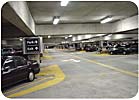

Table 1. Sample operating sequence
A product of incomplete combustion — that which occurs in internal combustion engines — CO is present in varying degrees in all vehicle exhaust systems. As little as 0.02 percent (200 ppm) CO concentration in air during a four-hour exposure period can cause severe effects such as nausea and dizziness. During the initial stages of CO poisoning, the victim’s judgment is often impaired, presenting the likelihood of a serious accident.
In enclosed areas such as parking garages, potentially lethal concentrations of CO can build up quickly — before exposed individuals have any indication of danger. At issue is notwhetherCO may reach hazardous concentrations, but rather how to control and ventilate it when itdoes.
Cost-effective operation
When garage ventilation and make-up air fans run continuously at peak output or even on a time-cycling basis, they run harder and longer than necessary, wasting energy, requiring more maintenance, and sustaining unnecessary wear.
Gas detection provides a reliable and cost-effective alternative. When used in conjunction with ventilation control equipment, continuously operating, permanently installed multi-point and single-point monitors can be used for fan activation only when a specified level of CO concentration (based on OSHA and building code requirements) is reached.
“Zoning” enables grouping of multiple sensors mounted within an area into a single zone. If any sensor detects gas, the ventilation system is activated. A zoned dual-level gas detection system allows ventilation fan operation as needed and on low speeds, in only the areas requiring ventilation due to CO buildup. When CO levels rise above a preset concentration, dampers are opened further and fans speed up, increasing their pitch for added ventilation. When the CO level drops, the fans slow down and decrease their pitch. (See Table 1.)
This method of operation generally results in the fans running at high speed only during relatively short periods of heavy traffic, which translates into lower power costs and greater energy savings than manually operated systems. It also provides better safety due to continuous monitoring.
What are your options?
Two types of sensing technologies are typically used in parking garage CO monitors: solid state or metal oxide semiconductor (MOS) sensors, and electrochemical sensors. Each has its strengths and drawbacks.Electrochemical sensorsare better for very specific and precise monitoring. Their strengths are: relatively specific to gas of interest; good accuracy; not significantly affected by humidity and temperature; low power requirements; linear output.
The drawbacks of these sensors include: relatively higher cost; limited operating life (generally less than two years); calibration required for zero and span concentrations.Solid state/MOS sensorsare usually sufficient for basic parking garage monitoring applications.
Their strengths are low cost and long life (2-10 years). Their drawbacks: cross-sensitive — not specific to CO and will respond to other toxic gases; lack of accuracy (they are affected by temperature changes and humidity); not as good as electrochemical sensors for measuring concentrations of 25 ppm and lower.
To offset costs, sample pump systems may be used. A pump and valve assembly draws air samples from various locations throughout the garage in a timed sequence. Since the sensors are shared, a smaller number is required. Drawbacks to this method include a lag time between sensing points (as only one area is monitored at a time), possible sample tube contamination, and increased maintenance needs due to a continuously running pump.
Where to place CO sensors
For parking garages, place sensors where the highest concentration of CO is expected: elevators, stairwells, offices, hallways, between adjacent parking aisles, and at roadway intersections within the garage. Also pay attention to public areas such as pay booths and elevator waiting areas, and to areas such as idling or stopping locations where CO buildup is most likely. Ensure that the area is sufficiently monitored by mounting additional sensors in little-used areas such as sub-basements and crawl spaces.
There is no set guideline for the correct number of sensors required to properly cover a facility. Divide the garage into zones and use those zones to coordinate fan operation. Place the monitor in the fan or control room and make sure that operators know its function and are trained in its use.
Since CO has the same density as air, sensors should be mounted in the “breathing zone” — about five to six feet up from the floor. Consider the airflow pattern around each sensor, and position it so that it avoids the direct path of outside air, fan airstreams or intake vents. Ventilation smoke tubes are useful for pinpointing air flow patterns.
Specifying your system
Factors to consider when specifying a CO monitoring system include:
• The size of the area to be monitored.
• Number of areas or zones: Sensors can be lumped together on a per-zone basis.
• Visual indication needs: Is a real-time concentration readout per sensor alarm indication at the panel or sensor location required, or will a common alarm indication suffice?
• Alarm contacts: Are they required, or will the user provide the control functions, therefore requiring only sensor/transmitters?
• Type of fuels used: If diesel-powered vehicles will be present, nitrogen dioxide (NO2) sensors will also be required.
• Auxiliary equipment: Include common relay outputs, ventilation, audible and visual alarms, and remote annunciation.
An affordable, effective CO monitoring system can be tailored to the requirements of any particular application. The number and placement of sensors or instruments and the sophistication of the control system depend upon the design of the garage and the level of flexibility desired.


